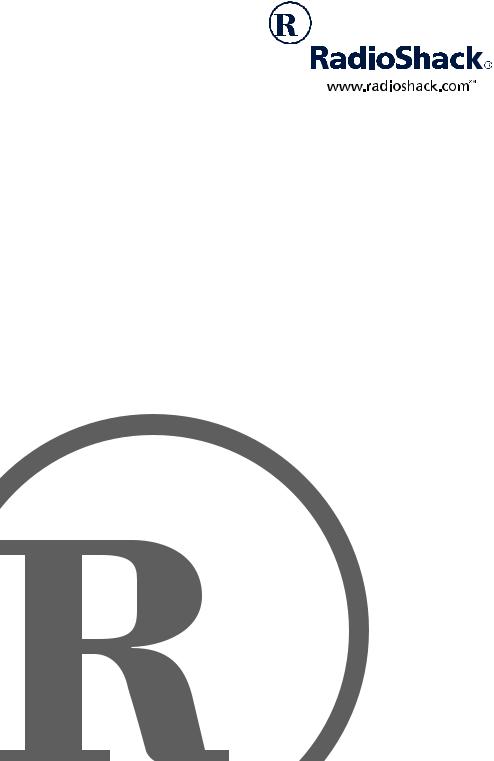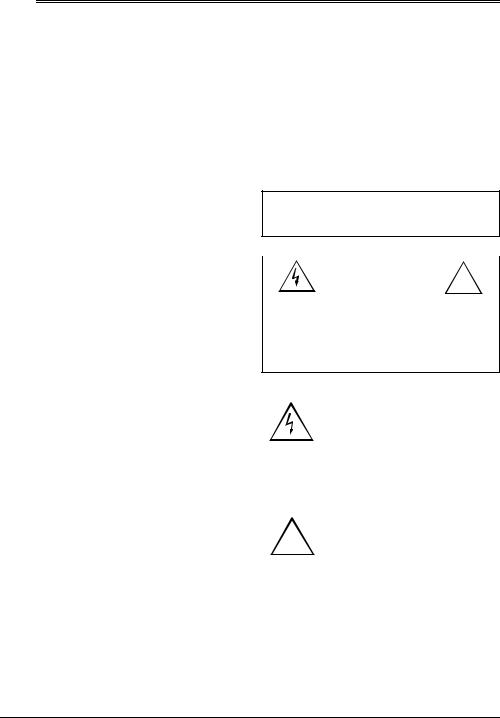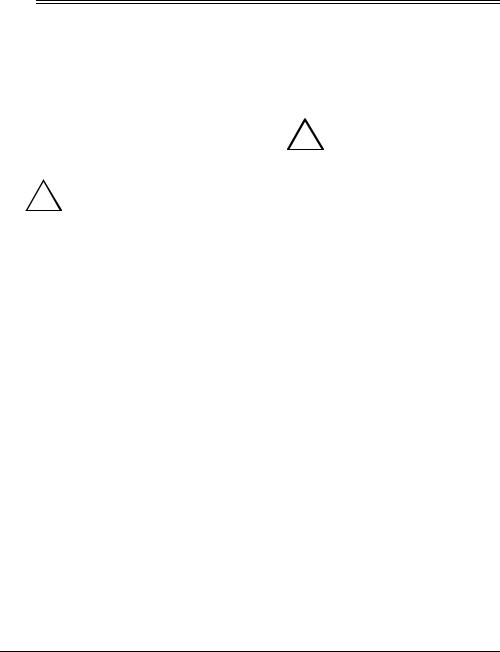Radio Shack PRO-2053 User Manual

PRO-2053
300 Channel Desktop
Trunk-Tracking Scanner
Owner’s Manual |
lease read before using this equipment. |

ˆ The FCC Wants You to Know
This equipment has been tested and found to comply with the limits for a scanning receiver pursuant to Part 15 of the FCC Rules. These limits are designed to provide reasonable protection against harmful interference in a residential installation. This equipment generates, uses and can radiate radio frequency energy and, if not installed and used in accordance with the instructions, may cause harmful interference to radio communications.
However, there is no guarantee that interference will not occur in a particular installation. If this equipment does cause harmful interference to radio or television reception, which can be determined by turning the equipment off and on, the user is encouraged to try to correct the interference by one or more of the following measures:
•Reorient or relocate the receiving antenna.
•Increase the separation between the equipment and receiver.
•Connect the equipment into an outlet on a circuit different from that to which the receiver is connected.
WARNING: MODIFICATION OF THIS DEVICE TO RECEIVE CELLULAR RADIOTELEPHONE SERVICE SIGNALS IS PROHIBITED UNDER FCC RULES AND FEDERAL LAW.
Note: Mobile use of this scanner is unlawful or requires a permit in some areas. Check the laws in your area.
WARNING: To reduce the risk of fire or shock hazard, do not expose this product to rain or moisture.
|
CAUTION |
! |
|
RISK OF ELECTRIC SHOCK. |
|
|
|
|
|
DO NOT OPEN. |
|
|
|
|
CAUTION: TO REDUCE THE RISK OF ELECTRIC SHOCK, DO NOT REMOVE COVER OR BACK. NO USER-SERVICE- ABLE PARTS INSIDE. REFER SERVICING TO QUALIFIED PERSONNEL.
This symbol is intended to alert you to the presence of uninsulated dangerous voltage within the product’s enclosure that might be of sufficient magnitude to constitute a risk of electric shock. Do not open the product’s case.
This device complies with Part 15 of the FCC
Rules. Operation is subject to the following
two conditions: |
! |
This symbol is intended to inform |
|
you that important operating and |
|
1. This device may not cause harmful inter- |
maintenance instructions are |
|
ference, and |
|
included in the literature accom- |
|
panying this product. |
|
|
|
2.This device must accept any interference received, including interference that may cause undesired operation.
©2001 RadioShack Corporation. All Rights Reserved.
RadioShack, RadioShack.com and Adaptaplug are trademarks used by RadioShack Corporation.
Hypersearch and Hyperscan are trademarks used by RadioShack Corporation.
Motorola, Smartnet and Privacy Plus are registered trademarks of Motorola Inc.
EDACS is a registered trademark of GE/Ericsson Inc.
2

ˆ Contents |
|
Features ...................................................................................................................... |
............ 6 |
Scanning Legally .............................................................................................................. |
7 |
Preparation ............................................................................................................................. |
8 |
Power Sources ................................................................................................................. |
8 |
Using AC Power ........................................................................................................ |
8 |
Using Vehicle Battery Power ..................................................................................... |
8 |
Connecting the Antenna ................................................................................................... |
9 |
Connecting an Outdoor Antenna ............................................................................... |
9 |
Connecting an Earphone/Headphones ............................................................................ |
9 |
Listening Safely ......................................................................................................... |
9 |
Traffic Safety ........................................................................................................... |
10 |
Connecting an Extension Speaker ................................................................................. |
10 |
Transferring Data to and from Another Scanner or a PC ............................................... |
10 |
About Your Scanner ............................................................................................................ |
10 |
A Look at the Keypad ..................................................................................................... |
10 |
Quick Start ....................................................................................................................... |
11 |
Understanding Banks ..................................................................................................... |
12 |
Channel Storage Banks .......................................................................................... |
12 |
Search Banks .......................................................................................................... |
12 |
Understanding Your Scanner's Modes ........................................................................... |
12 |
AM Mode ................................................................................................................. |
12 |
FM Mode ................................................................................................................. |
12 |
Motorola Mode ........................................................................................................ |
12 |
EDACS Mode .......................................................................................................... |
13 |
Open and Closed Modes ........................................................................................ |
14 |
Operation .............................................................................................................................. |
14 |
Turning on the Scanner and Setting Squelch ................................................................. |
14 |
Storing Known Frequencies into Channels .................................................................... |
15 |
Storing Trunking Frequencies into Channels ................................................................. |
16 |
Storing Text Tags ............................................................................................................ |
16 |
Assigning a Text Tag to a Channel .......................................................................... |
16 |
Assigning a Text Tag to a Group ID ......................................................................... |
17 |
Assigning a Text Tag to a Bank ............................................................................... |
17 |
Text Input Chart ....................................................................................................... |
17 |
Finding and Storing Active Frequencies ......................................................................... |
18 |
Searching a Preprogrammed Frequency Range ..................................................... |
18 |
Searching Active Frequencies in Your Desired Frequency Range ......................... |
22 |
Manually Tuning a Frequency ................................................................................. |
23 |
Listening to the Weather Band ....................................................................................... |
23 |
Listening to a Weather Channel .............................................................................. |
24 |
Displaying Weather Messages ................................................................................ |
24 |
WX Alert and Beep Tone Confirmation .................................................................... |
24 |
Using Frequency Copy Function .................................................................................... |
24 |
Contents |
3 |

Copying a Frequency into a Specified Channel ....................................................... |
24 |
Copying a Frequency into a Vacant Channel in a Specified Bank ........................... |
25 |
Copying a Frequency into the Priority Channel ....................................................... |
25 |
Scanning the Channels ................................................................................................... |
25 |
Turning Channel-Storage Banks Off and On ........................................................... |
25 |
Deleting Frequencies from Channels ....................................................................... |
26 |
Special Features ................................................................................................................... |
26 |
Using the Delay Function ................................................................................................ |
26 |
Locking Out Channels or Frequencies ............................................................................ |
26 |
Locking Out Channels ............................................................................................. |
26 |
Reviewing the Lock-Out Channels ........................................................................... |
26 |
Locking Out Frequencies ......................................................................................... |
26 |
Reviewing Locked-Out Frequencies ........................................................................ |
27 |
Clearing a Locked-Out Frequency ........................................................................... |
27 |
Clearing All Locked-Out Frequencies in a Search Bank .......................................... |
27 |
Priority ............................................................................................................................. |
27 |
Changing the Receive Mode ........................................................................................... |
28 |
Using the Attenuator ....................................................................................................... |
29 |
Turning the Key Tone On and Off .................................................................................... |
29 |
Changing the Display Contrast ....................................................................................... |
29 |
Cloning Programmed Data .............................................................................................. |
29 |
Trunking Operation .............................................................................................................. |
30 |
Understanding Trunking .................................................................................................. |
31 |
Setting Squelch for the Trunking Mode ........................................................................... |
31 |
Programming Trunking Frequencies ............................................................................... |
31 |
Programming Motorola Trunking Systems (UHF-Lo) ............................................... |
32 |
Programming Motorola Trunking System (800 MHz) ............................................... |
33 |
Programming Fleet Maps ......................................................................................... |
33 |
Talk Group IDs ......................................................................................................... |
35 |
Storing Talk Group IDs ............................................................................................. |
35 |
Talk Group ID Hold ................................................................................................... |
36 |
Turning Sub-Banks On or Off ................................................................................... |
36 |
Locking Out Talk Group IDs ..................................................................................... |
37 |
Delay Function in ID Indication Mode ...................................................................... |
37 |
Reviewing Locked-Out Talk Group IDs .................................................................... |
37 |
Clearing Talk Group IDs ........................................................................................... |
37 |
Clearing All Talk Group IDs in One Bank ................................................................. |
37 |
Open and Closed Modes ................................................................................................ |
38 |
Changing the Open/Closed Mode ............................................................................ |
38 |
A General Guide to Frequencies ......................................................................................... |
38 |
US Weather Frequencies in MHz ............................................................................ |
38 |
Ham Radio Frequencies .......................................................................................... |
39 |
Birdie Frequencies ................................................................................................... |
39 |
Guide to the Action Bands .............................................................................................. |
40 |
Typical Band Usage ................................................................................................. |
40 |
Primary Usage ......................................................................................................... |
41 |
Band Allocation ............................................................................................................... |
42 |
4 |
Contents |

Frequency Conversion ................................................................................................... |
49 |
Troubleshooting ................................................................................................................... |
50 |
Resetting/Initializing the Scanner ................................................................................... |
50 |
Resetting the Scanner ............................................................................................. |
50 |
Initializing the Scanner ............................................................................................ |
50 |
Care ................................................................................................................................ |
51 |
Specifications ...................................................................................................................... |
52 |
Contents |
5 |

ˆ Features
Your RadioShack Base Scanner is one of a new generation of scanners designed to track Motorola Type I and II (such as Smartnet and Privacy Plus ) and hybrid analog trunking systems, and GE/Ericsson (EDACS ) type systems, used extensively in many communication systems.
Trunking communications systems let a large group of 2-way radio users (or even different groups of 2-way radio users) efficiently use a set of frequencies. Instead of selecting a specific frequency for a transmission, the user simply selects a talk group. The trunking system automatically transmits the call on the first available frequency, and also sends a code that uniquely identifies that transmission.
Since the trunking system might send a call and its response on different frequencies, it is difficult to listen to trunked communications using a regular scanner. The trunking scanner monitors the data sent with a 2-way radio transmission, so you can hear the call and response for that user and more easily "follow" the conversation.
The scanner also lets you scan conventional transmissions, and is preprogrammed with service search banks for convenience. By pressing a single button, you can quickly search those frequencies most commonly used by public service and other agencies.
This scanner gives you direct access to over 59,000 frequencies including those used by police and fire departments, ambulance services, government agencies, air, and amateur radio services.
Your scanner includes these features:
Simultaneous Trunking Operation — tracks two trunking systems (Motorola and
EDACS) and conventional systems at the same time.
Automatic Channel Programming — automatically determines the group trunking frequencies, for Motorola trunking systems only, once the control channels are programmed.
10 Channel-Storage Banks — let you store
30 channels in each bank (300 channels) to group channels so calls are easier to identify.
10 ID-Storage Banks — let you store 1,000 IDs in 10 ID banks that have 5 sub-ID banks. 20 IDs are programmed in each sub-ID bank and let you easily identify the ID code.
Weather Alert — automatically sounds the alarm tone to advise of hazardous weather conditions when it detects the alert signal on the local National Oceanic and Atmospheric Administration (NOAA) weather channel during priority operation.
Digital Weather Alert — displays the weather event text with four alert levels so you can see and hear the reason for the alert.
Data Cloning — lets you transfer the programmed data to another PRO-2053 or PRO-93 scanner. You can also upload or download the programmed data to or from a PC using an optional PC interface kit.
12-Character, 4-Line, Alphanumeric Display — shows you detailed operating information clearly.
Triple Conversion Superheterodyne Receiver — virtually eliminates any interference from intermediate frequency (IF) images, so you hear only the frequency you select.
6 |
Features |

Preprogrammed Frequency Ranges — let you search for transmissions within preset frequency ranges or within ranges you set, to reduce search time and select interesting frequencies more quickly.
Hyperscan™ and Hypersearch™ — allow scans at up to 60 channels per second and searches up to 75 frequencies per second, to help you quickly find transmissions.
Scan Delay — delays scanning for about 2 seconds before moving to another channel in conventional mode, so you can hear more replies on the same channel.
Priority Channel — lets you set the scanner to check one channel every 2 seconds so you do not miss transmissions.
Attenuate — lets you program your scanner to reduce the scanner's sensitivity to strong local signals, to reduce interference or noise caused by these signals.
Text Input — lets you input a text label for each channel, talk group ID, bank, or other memory location so you can easily identify the transmission.
Lock Out Function — lets you set your scanner to skip over specified channels or frequencies when scanning or searching, and skip over IDs when tracking trunked systems.
Telescoping Antenna — provides excellent reception.
External BNC Antenna Connector — lets you connect an external antenna (not supplied) to the scanner.
Memory Backup — keeps the frequencies stored in memory for an extended time even without internal batteries.
Supplied Trunking Guide — provides a quick reference to public safety trunking radio systems in the United States.
Your scanner can receive these frequencies:
•25–54 MHz
•108–136.9875 MHz
•137–174 MHz
•216.0025–225 MHz
•406–512 MHz
•806–823.9875 MHz
•849–868.9875 MHz
•894–960 MHz
•1240–1300 MHz
Use “A General Guide to Frequencies” on Page 38 to help you target frequency ranges in your service area so you can search for a wide variety of transmissions.
SCANNING LEGALLY
Scanning is a fun and interesting hobby. You can hear police and fire departments, ambulance services, government agencies, private companies, amateur radio services, aircraft, and military operations. It is legal to listen to almost every transmission your scanner can receive. However, there are some electronic and wire communications that are illegal to intentionally intercept. These include:
•telephone conversations (cellular, cordless, or other private means of telephone signal transmission)
•pager transmissions
•scrambled or encrypted transmissions
According to the Federal Electronic Communications Privacy Act (ECPA), as amended, you could be fined and possibly imprisoned for intentionally listening to, using, or disclos-
Features |
7 |

ing the contents of such a transmission unless you have the consent of a party to the communication (unless such activity is other-
wise illegal). These laws change from time to time and there might be state or local laws that also affect legal scanner usage.
ˆ Preparation
POWER SOURCES
Using AC Power
You can power the scanner using the supplied 12V, 500 mA AC adapter.
Cautions:
You must use a Class 2 power
!source that supplies 12V DC and delivers at least 500 mA.
Its center tip must be set to positive and its plug must fit the scanner's
jack. The supplied adapter meets these specifications. Using an adapter that does not meet these specifications could damage the scanner or the adapter.
•Always connect the AC adapter to the scanner before you connect it to AC power. When you finish, disconnect the adapter from AC power before you disconnect it from the scanner.
Follow these steps to power the scanner from a standard AC outlet.
1.Insert the AC adapter’s barrel plug into the DC 12V jack on the back of the scanner.
2.Plug the adapter’s two-prong plug into a standard AC outlet.
Using Vehicle Battery Power
You can power the scanner from a vehicle’s 12V power source (such as a cigarette-light- er socket) using an optional 12 volt power
cord, and a size D Adaptaplug™ adapter (available at your local RadioShack store).
Cautions:
You must use a power cord
!that supplies 12V DC and delivers at least 500 mA. Its
center tip must be set to positive and its plug must fit the scanner's DC 12V jack. Using an cord that does not meet these specifications could damage the scanner or the cord.
•Always connect the adapter to the scanner before you connect it to the power source. When you finish, disconnect the DC adapter from the power source before you disconnect it from the scanner.
Follow these steps to connect a 12V power source.
1.Confirm the adapter’s center tip is set to positive.
2.Insert the adapter’s barrel plug into the DC 12V jack on the back of the scanner.
3.Plug the adapter’s DC plug into the 12V DC power source, such as a vehicle’s cigarette-lighter socket.
Note: If the scanner does not operate properly when you connect a DC adapter, unplug the DC adapter from the power source and clean the socket, or check the adapter’s internal fuse.
8 |
Preparation |

CONNECTING THE ANTENNA
You must install an antenna before you can operate the scanner.
To attach the supplied antenna to the antenna jack on the top of your scanner, thread the antenna clockwise into the hole on the top of the scanner.
The scanner's sensitivity depends on its location and the antenna's length. For the best reception of the transmissions you want to hear, adjust the antenna's length according to the chart below.
Frequency |
Antenna Length |
25–54 MHz |
Extend fully |
108–174 MHz |
Extend 4 segments |
216–225 MHz |
Extend 3 segments |
406–1300 MHz |
Collapse fully |
Connecting an Outdoor Antenna
Instead of the supplied antenna, you can connect an outdoor base-station or mobile antenna (neither supplied) to your scanner. Your local RadioShack store sells a variety of antennas.
When deciding on an outdoor antenna and its location, consider these points:
•The antenna should be located as high as possible.
•The antenna and antenna cable should be as far as possible from sources of electrical noises (appliances, other radios, and so on).
•The antenna should be vertical for the best performance.
To connect an optional base-station or mobile antenna, first remove the supplied anten-
na from the scanner. Always use 50 ohm coaxial cable, such as RG-58 or RG-8, to connect the base-station or mobile antenna. For lengths over 50 feet, use RG-8 low-loss dielectric coaxial cable. If the antenna's cable does not have a BNC connector, you will also need a BNC adapter (also available at your local RadioShack store). Your local RadioShack store carries a wide variety of coaxial antenna cable and connectors.
Once you choose an antenna, follow the mounting instructions supplied with the antenna. Then route the antenna's cable to the scanner and connect the cable to the ANT connector.
Warning: Use extreme caution when installing or removing an outdoor antenna. If the antenna starts to fall, let it go! It could contact overhead power lines. If the antenna touches a power line, contact with the antenna, mast, cable or guy wires can cause electrocution and death! Call the power company to remove the antenna. Do not attempt to do so yourself.
Caution: Do not run the cable over sharp edges or moving parts that might damage it.
CONNECTING AN EARPHONE/ HEADPHONES
For private listening, you can plug an 1/8-inch (3.5 mm) mini-plug earphone or headphones (not supplied), available at your local RadioShack store, into the  jack on the front of your scanner. This automatically disconnects the internal speaker.
jack on the front of your scanner. This automatically disconnects the internal speaker.
Listening Safely
To protect your hearing, follow these guidelines when you use an earphone or headphones.
•Do not listen at extremely high volume levels. Extended high-volume listening can lead to permanent hearing loss.
Preparation |
9 |

•Set the volume to the lowest setting before you begin listening. After you begin listening, adjust the volume to a comfortable level.
•Once you set the volume, do not increase it. Over time, your ears adapt to the volume level, so a volume level that does not cause discomfort might still damage your hearing.
Traffic Safety
Do not wear an earphone or headphones while you drive a vehicle or ride a bicycle. This can create a traffic hazard and can be illegal in some areas. Even though some earphones and headphones let you hear some outside sounds when you listen at normal levels, they still can present a traffic hazard.
CONNECTING AN EXTENSION SPEAKER
In a noisy area, an extension speaker (not supplied), available at your local RadioShack store, might provide more comfortable listening. Plug the speaker cable's 1/8-inch (3.5 mm) mini-plug into your scanner's
jack.
TRANSFERRING DATA TO AND FROM ANOTHER SCANNER OR A PC
You can transfer the programmed data to and from another PRO-2053 or PRO-93 using a connecting cable which has 1/8-inch phone plugs on both ends (not supplied). Connect the cable between each scanner's PC/IF jacks. See “Cloning Programmed Data” on Page 29. You can also upload or download the programmed data to or from a PC using an optional PC interface kit available through your local RadioShack store.
ˆ About Your Scanner
Once you understand a few simple terms used in this manual and familiarize yourself with your scanner's features, you can put the scanner to work for you. You simply determine the type of communications you want to receive, then set the scanner to scan them.
A frequency is the receiving signal location (expressed in kHz or MHz). To find active frequencies, you can use the tune function.
You can also use the SEARCH banks, which are preprogrammed frequencies in the scanner's memory (see “Searching a Preprogrammed Frequency Range” on Page 18 for the frequency list). You can even change the frequency range on one of the SEARCH banks (SR5) to limit the search.
When you find a frequency, you can store it into a programmable memory location called a channel, which is grouped with other channels in a channel-storage bank. You can then scan the channel-storage banks to see if there is activity on the frequencies stored there. Each time the scanner finds an active frequency, it stays on that channel until the transmission ends.
A LOOK AT THE KEYPAD
Here is a brief overview of your scanner's keys and their functions.
SCAN — scans through the programmed channels.
10 |
About Your Scanner |

FUNC (function) — lets you use various functions by pressing this key in combination with other keys.
MAN — stops scanning and lets you directly enter a channel number.
WX — scans through the seven preprogrammed weather channels.
TRUNK — stores the trunking ID code or holds the trunking ID while scanning.
PRI (Priority) — sets and turns the priority function on or off.
TEXT — lets you input text.
PAUSE — stops search.
MODE — changes the receive mode (AM, FM, MOT, ED).
TUNE — lets you input a frequency and allows you to fine tune a frequency along with 8or 9.
ATT (Attenuate) — turns attenuation on to reduce the scanner's sensitivity and block extremely strong signals, or turns it off to increase sensitivity.
8or 9— selects the scan or search direction.
SEARCH — lets you search the six search banks.
L/OUT (Lock Out) — lets you lock out a selected channel, skip a specified frequency during search, or lock out a selected ID code.
PROG — programs frequencies into channels.
ENTER — completes the entry of frequencies and text.
1 — enters a 1, or inputs characters 0 through 9 in text mode.
2/ABC — enters a 2, or inputs characters A, B, or C.
3/DEF — enters a 3, or inputs characters D, E, or F.
4/GHI — enters a 4, or inputs characters G, H, or I.
5/JKL — enters a 5, or inputs characters J, K, or L.
6/MNO — enters a 6, or inputs characters M, N, or O.
7/PQRS — enters a 7, or inputs characters P, Q, R, or S.
8/TUV — enters an 8, or inputs characters T, U, or V.
9/WXYZ — enters a 9, or inputs characters W, X, Y, or Z.
0 — enters a zero, or inputs characters ., -, #, _, @, +, *, &, /, ', $, %, !, ^, (, ), ?, ->, ` or <-.
./DELAY — enters a decimal point (necessary when programming frequencies), space, or programs delay time for the selected channel/search bank, or hyphen (in trunking ID setting).
CLEAR — clears an incorrect entry.
QUICK START
To help familiarize yourself with the scanner’s functions, keypad, and available frequencies, you can utilize one of these three features before you begin programming the scanner.
Preprogrammed Search Banks — let you listen to frequencies and decide which ones you want to store when you are ready to program the scanner. See “Searching a Preprogrammed Frequency Range” on Page 18.
About Your Scanner |
11 |

Manual Tuning — allows you to manually scan through the entire range of available frequencies without programming. (See “Specifications” on Page 52 for a list of the available frequency ranges.)
Weather Radio — allows you to listen to NOAA weather broadcasts without programming. See “Listening to the Weather Band” on Page 23.
UNDERSTANDING BANKS
Channel Storage Banks
A bank is a storage area for a group of channels. Channels are storage areas for frequencies. Whereas a channel can only contain one frequency, a bank can hold numerous channels.
To make it easier to identify and select the channels you want to listen to, your scanner divides the channels into 10 banks (ò to é) of 30 (òò to ðé) channels each, a total of 300 channels. You can use each channel-stor- age bank to group frequencies, such as those used by Motorola trunking, EDACS trunking, Marine, CB, Police, Fire, Aircraft and Ham (see “Typical Band Usage” on Page 40).
For example, a police department might use four frequencies, one for each side of town. You could program the police frequencies starting with òòò (the first channel in bank 0) and program the fire department frequencies starting with ñòò (the first channel in bank 1). The first digit identifies the bank (ò to é). The second and third digits identify the channel within the bank (òò to ðé).
Search Banks
Your scanner has five preprogrammed search banks and one limit search bank. You can set the lower and higher frequency limit in the limit search bank. (For the default set-
ting, see “Searching a Preprogrammed Frequency Range” on Page 18).
UNDERSTANDING YOUR SCANNER'S MODES
You can program each channel with any of four receive modes (AM, FM, MOT, and ED). However, you can not program MOT (Motorola), or ED (EDACS) mode in VHF. Each receive mode affects how your scanner operates when scanning and receiving transmissions, and also affects what transmissions you receive when you set the scanner to the closed mode. See “Changing the Receive Mode” on Page 28.
AM Mode
The AM mode sets the scanner to receive transmissions using amplitude modulation (AM), primarily used for CB, aircraft, military, some amateur radio, and some government transmissions. (Refer to “Specifications” on Page 52 for a list of the frequencies covered.) When the scanner receives a transmission on a channel set to the AM mode, it always stops on the transmission.
FM Mode
The FM mode sets the scanner to receive transmissions using frequency modulation (FM), used for most public safety transmissions, as well as broadcast, business, and amateur radio transmissions. When the scanner receives a transmission on a channel set to the FM mode, it always stops on the transmission.
Motorola Mode
You can set your scanner so it decodes the talk group IDs used with Motorola trunking systems. This setting is called the Motorola mode.
12 |
About Your Scanner |

Motorola systems are trunking systems used primarily by business and public safety groups to efficiently allocate a small number of frequencies (as few as five) to many groups of users (as many as several thousand). To do this, each group of users in the system is assigned to a specific talk group. For example, the east side patrol officers might all be assigned to talk group 2160. One channel in the system is continuously transmitting data that identifies which talk groups are active on which channel. In addition, this talk group information is also transmitted as subaudible data on each active channel.
When the scanner receives a transmission on a channel set to the Motorola mode, it first decodes the talk group ID data included with the transmission. In the open mode, the scanner stops on the transmission and displays the talk group ID on the bottom line of the display. In the closed mode, the scanner only stops on the transmission if the talk group ID matches a talk group ID that you have stored in the bank's talk group ID list and have not locked out.
Motorola trunking systems come in three categories: Type I, Type II, and Type I/II Hybrid. Each category displays and uses talk group IDs in slightly different ways.
Motorola Type I IDs are in the form FFF-SS, where:
FFF=Fleet ID
SS=Subfleet ID
Type I systems are usually organized with different user groups assigned to different fleets. For example, a valid fleet-subfleet ID identifying all detectives within a police department might be òòòVñð, where 000 identifies all police users and 12 identifies the Detective division.
To properly map the raw Type I data to the correct fleet-subfleet format, you must program the correct fleet map into the scanner. Fleet map information is widely available on the Internet for most Type I systems in use.
Type II system talk groups are identified by a 5-digit number. Valid talk group IDs are divisible by 16. If you try to enter an invalid talk group ID, the scanner rounds the ID down to the next valid ID.
Type I/II hybrid systems use both fleet-sub- fleet and 5-digit formats for talk group IDs.
Note: If the scanner decodes control channel data while receiving transmissions from a Motorola trunking system, á*0.( appears on the bottom line of the display.
EDACS Mode
You can set your scanner so it decodes the talk group IDs used with EDACS (GE/Ericsson) trunking systems. This setting is called the EDACS mode.
EDACS systems are trunking systems used primarily by business or private communications service providers, as well as by some public safety organizations. EDACS systems transmit active talk group information only on a dedicated control channel.
EDACS frequencies are organized in a specific order. Each frequency is assigned a Logical Channel Number (LCN). For the scanner to correctly switch to an active frequency, you must program the frequencies in LCN order, starting with )<DFIPýòñ. EDACS talk group IDs are entered as a 4-digit decimal number from 0001 to 2047 or AFS (Agency Fleet Subfleet) number from 00-001 to 15-157.
When there is activity on an EDACS system, that information is sent out on the control channel. The scanner decodes the ID for the active talk group. In the open mode, the
About Your Scanner |
13 |

scanner then goes to the transmission and displays the talk group ID on the bottom line of the display. In the closed mode, the scanner only goes to transmissions with IDs that match talk group IDs you stored in the bank's talk group ID list which are not locked out.
Because EDACS scanning requires clear reception of the control channel at all times, EDACS systems tend to have a smaller usable area. An external antenna can greatly improve EDACS scanning in a fringe area. If you are having trouble scanning an EDACS system, try manually selecting the data channel. If you are getting good reception, the scanner will indicate talk group á0(Vòñ. Try changing your location or using an outdoor antenna to improve reception.
Open and Closed Modes
You can set your scanner to change the way it receives signals. These settings, called open mode and closed mode, affect how the scanner receives signals from communications systems that use some type of closed squelch (such as Motorola and EDACS systems).
You can set each of the scanner's channel storage banks to open or closed mode.
In open mode, the scanner scans signals transmitted in all systems. In closed mode, the scanner scans signals transmitted only under the following conditions:
•When the signals are in the FM mode.
•When the signals are in the MOT, or ED mode and the signal's ID code matches the programmed ID code.
You can also select the user or talk groups you want the scanner to receive in closed mode.
When you set a channel storage bank to open mode, ö appears under the bank's number while scanning. When you set a channel storage bank to closed mode, V appears under the channel storage bank's number while scanning. +,!* or á(+/! appears while the scanner is in manual mode or while the scanner is receiving a signal during scanning. See “Changing the Open/ Closed Mode” on Page 38 for more information about setting the open and closed modes.
ˆ Operation
TURNING ON THE SCANNER AND SETTING SQUELCH
1.Turn SQUELCH fully counterclockwise until the indicator points to MIN before you turn on the scanner.
2.To turn on the scanner, turn VOLUME
clockwise. 3<C:FD<ý 0Fý L8Cý 0ILEB@E>
appears. After about 3 seconds, you hear a hissing sound.
3.Turn SQUELCH clockwise until the hissing sound stops.
4.To turn off the scanner, turn VOLUME counterclockwise to OFF.
Notes:
•The scanner does not scan if there are no frequencies stored in channels. If the scanner does not scan and you have already stored frequencies in channels, turn SQUELCH further clockwise.
•If the scanner picks up unwanted, partial, or very weak transmissions, turn SQUELCH clockwise to decrease the
14 |
Operation |

scanner's sensitivity to these signals. If you want to listen to a weak or distant station, turn SQUELCH counterclockwise.
•If SQUELCH is adjusted so you always hear a hissing sound, the scanner will not scan properly.
•To ensure the scanner operates properly while in the trunking mode, we suggest you set SQUELCH using the steps listed above.
STORING KNOWN
FREQUENCIES INTO
CHANNELS
Good references for active frequencies are
RadioShack's Police Call, Aeronautical Frequency Directory, and Maritime Frequency Directory. We update these directories every year, so be sure to get a current copy. Also see the supplied Trunking Guide.
Note: If you are storing frequencies for an EDACS system, you must store them in logical channel number order, with the first frequency in channel 1 for the current bank.
Follow these steps to store frequencies into channels.
1.Press MAN, enter the bank (0–9) and channel number (00–29) where you want to store a frequency, then press MAN again. ) and the bank and channel number appear at the upper left corner of the display (for example: )òòò).
Note: When ) is on the display, you can also select your desired bank and channel number with the FUNC and arrow keys.
•Press FUNC then press 8 or 9. The bank number moves in the direction of the arrow pressed.
•Press FUNC then press and hold 8 or 9. The bank number moves continuously in the assigned direction.
•Press 8. The channel number
moves upward one by one. Or, press 9. The channel number moves downward one by one.
2.Press PROG. ) changes to ,.
3.Use the number keys and ./DELAY to enter the frequency (including the decimal point) you want to store.
If you make a mistake, press CLEAR to delete a single digit or press and hold CLEAR about 2 seconds to delete all digits.
4.Press ENTER to store the frequency into the channel.
Notes:
•If you made a mistake in Step 3, %EM8C@; "I<H briefly appears and the scanner beeps when you press ENTER. Start again from Step 3.
•Your scanner automatically rounds the entered frequency to the nearest valid frequency. For example, if you enter a frequency of 151.553, your scanner accepts it as снсфннт.
•To have the scanner pause for 2 seconds on a channel after a transmission before proceeding to the next active transmission, press ./DELAY to turn the delay function on. See “Using the Delay
Operation |
15 |

Function” on Page 26. The scanner stores this setting in the channel.
5.If necessary, press MODE to change the receiving mode.
6.If desired, program a text tag for the channel (see “Assigning a Text Tag to a Channel”").
7.The next channel in sequence is ready for programming. Press PROG and then repeat steps 3 through 6.
STORING TRUNKING
FREQUENCIES INTO
CHANNELS
1.Press PROG and FUNC then 8or 9to select the desired bank to program.
2.Press TRUNK to enter into trunking mode.
3.Repeatedly press MODE to select )+0 (Motorola) or ! (EDACS).
4.Press PROG and select the channel number using 8or 9.
5.Enter the UHF trunking frequency and press ENTER.
6.Repeat Steps 4 and 5 to enter the other trunking group frequencies for EDACS or control channel frequencies for Motorola trunking.
7.If necessary, press MODE to change the receiving mode.
STORING TEXT TAGS
You can customize your scanner by storing text tags (up to 12 characters) for easy identification of channel transmissions, trunk IDs, or banks.
Assigning a Text Tag to a Channel
1.Press MAN, enter the channel number where you want to enter the text, then press MAN again. ) and the bank and channel number appear at the upper left corner of the display (for example: )ñòò).
2.Press PROG. ) changes to ,.
3.Press TEXT. The cursor appears at the third line.
4.Enter the text using the numeral keys (see “Text Input Chart” on Page 17).
Note: If you make a mistake, press 8 or 9to move to the character you want to change.
For example, to identify amateur (Ham) radio transmissions in the 6 meter range, input "HAM 6m" as follows:
•"H" is the second letter associated with 4 on the keypad. Press 4 then 2.
•"A" is the first letter associated with 2 on the keypad. Press 2 then 1.
•"M" is the first letter associated with 6 on the keypad. Press 6 then 1.
•"Space." Press ./DELAY.
•"6" is the sixth number associated with 1 on the keypad. Press 1 then 6.
•"m" is the first letter associated with 6 on the keypad. Press 6 and FUNC (for the lower case set), then press 1.
5.Press ENTER to input the text.
16 |
Operation |

Assigning a Text Tag to a Group ID
1.Press PROG.
2.Press TRUNK.
3.Press FUNC then 8 or 9 to select the desired bank.
4.Press TRUNK to select the desired subbank.
5.Press or hold down 8 or 9 to select the desired group ID.
6.Press TEXT then enter the tag using the keypad. (See “Text Input Chart”.)
7. Press ENTER to store.
Assigning a Text Tag to a Bank
1.Select a channel within the desired bank by pressing MAN and entering the bank number (000 for bank 0 or 200 for bank 2, for example). Press MAN again.
2.Press PROG.
3.Press FUNC then 7. The cursor appears at the third line of the display. Enter the text using the keypad. (See “Text Input Chart”.)
4.Press ENTER to store.
Text Input Chart
Notes:
•To access the numbers, after you press TEXT (when you assign the text tag to a channel) or you press FUNC and 7 (when you assign the text tag to a bank), press 1. Then press the desired number you want to enter.
•To enter a lowercase character or a character from the second set for key 0, press FUNC after pressing the first numeral key.
BUTTONS PRESSED |
CHARACTERS ENTERED |
BUTTONS PRESSED |
CHARACTERS ENTERED |
|
|
|
|
|
|
|
|
1 |
0 1 2 3 4 5 6 7 8 9 |
2 |
A B C |
|
|
|
|
2 then FUNC |
a b c |
3 |
D E F |
|
|
|
|
3 then FUNC |
d e f |
4 |
G H I |
|
|
|
|
4 then FUNC |
g h i |
5 |
J K L |
|
|
|
|
5 then FUNC |
j k l |
6 |
M N O |
|
|
|
|
6 then FUNC |
m n o |
7 |
P Q R S |
|
|
|
|
7 then FUNC |
p q r s |
8 |
T U V |
|
|
|
|
8 then FUNC |
tuv |
9 |
W X Y Z |
|
|
|
|
9 then FUNC |
w x y z |
0 |
. - # _ @ + * & / , |
|
|
|
|
0 then FUNC |
$ % ! ^ ( ) ? -> ` <- |
./DELAY |
Space |
|
|
|
|
Operation |
17 |
